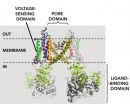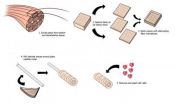Research by CU-Boulder physicists creates 'recipe book' for building new materials
2012-12-28
(Press-News.org) By showing that tiny particles injected into a liquid crystal medium adhere to existing mathematical theorems, physicists at the University of Colorado Boulder have opened the door for the creation of a host of new materials with properties that do not exist in nature.
The findings show that researchers can create a "recipe book" to build new materials of sorts using topology, a major mathematical field that describes the properties that do not change when an object is stretched, bent or otherwise "continuously deformed." Published online Dec. 23 in the journal Nature, the study also is the first to experimentally show that some of the most important topological theorems hold up in the real material world, said CU-Boulder physics department Assistant Professor Ivan Smalyukh, a study senior author.
The research could lead to upgrades in liquid crystal displays, like those used in laptops and television screens, to allow them to interact with light in new and different ways. One possibility is to create liquid crystal displays that are even more energy efficient, Smalyukh said, extending the battery life for the devices they're attached to.
The research was funded in part by Smalyukh's Presidential Early Career Award for Scientists and Engineers, which he received from President Barack Obama in 2010. And the research supports the goals laid out by the White House's Materials Genome Initiative, Smalyukh said, which seeks to deploy "new advanced materials at least twice as fast as possible today, at a fraction of the cost."
Smalyukh, postdoctoral researcher Bohdan Senyuk, and doctoral student Qingkun Liu set up the experiment by creating colloids — solutions in which tiny particles are dispersed, but not dissolved, throughout a host medium. Colloids are common in everyday life and include substances such as milk, jelly, paint, smoke, fog and shaving cream.
For this study, the physicists created a colloid by injecting tiny particles into a liquid crystal — a substance that behaves somewhat like a liquid and somewhat like a solid. The researchers injected differently shaped particles that represent fundamental building-block shapes in topology. That means each of the particles is distinct from the others and one cannot be turned into the other without cutting or gluing. Objects that look differently can still be considered the same in topology if one can be turned into the other by stretching or bending – types of "continuous deformations."
In the field of topology, for example, an object shaped like a donut and an object shaped like a coffee cup are treated the same. That's because a donut shape can be "continuously deformed" into a coffee cup by indenting one side of the donut. But a donut-shaped object cannot be turned into a sphere or a cylinder because the hole in the donut would have to be eliminated by "gluing" the sides of the donut back together or by "cutting" the side of the donut.
Once injected into a liquid crystal, the particles behaved as predicted by topology. "Our study shows that interaction between particles and molecular alignment in liquid crystals follows the predictions of topological theorems, making it possible to use these theorems in designing new composite materials with unique properties that cannot be encountered in nature or synthesized by chemists," Smalyukh said. "These findings lay the groundwork for new applications in experimental studies of low-dimensional topology, with important potential ramifications for many branches of science and technology."
###
The study was co-authored by Sailing He of Zhejiang University in China; Randall Kamien and Tom Lubensky of the University of Pennsylvania, and Robert Kusner of the University of Massachusetts, Amherst.
ELSE PRESS RELEASES FROM THIS DATE:
2012-12-28
CHICAGO (December 28, 2012): When researchers from UCLA Medical Center investigated the link between racial disparities and appendicitis outcomes in children, they found that the type of hospital in which black, Hispanic and other minority patients receive care—community, children's or county—affects their odds of developing a perforated appendix. The study published in the January issue of the Journal of the American College of Surgeons is a first-of-its-kind look at the role hospital type plays in race-based treatment variances among this patient subset.
Appendicitis—a ...
2012-12-28
A new study, published December 27 in the open access journal PLOS Biology, finds that vector-borne and parasitic diseases have substantial effects on economic development across the globe, and are major drivers of differences in income between tropical and temperate countries. The burden of these diseases is, in turn, determined by underlying ecological factors: it is predicted to rise as biodiversity falls. This has significant implications for the economics of health care policy in developing countries, and advances our understanding of how ecological conditions can ...
2012-12-28
Australian scientists have shown in the laboratory how a 'transcription factor' causes breast cancer cells to develop an aggressive subtype that lacks sensitivity to estrogen and does not respond to known anti-estrogen therapies. The research, which has significant implications for breast cancer treatment, is published December 27 in the open access journal PLOS Biology.
Transcription factors are molecules that switch genes on or off. In this case, the transcription factor known as 'ELF5' inhibits sensitivity to estrogen very early in the life of a breast cancer cell. ...
2012-12-28
(SALT LAKE CITY–Researchers have discovered that adding lovastatin, a widely used cholesterol-lowering drug, to traditional antimalarial treatment decreases neuroinflammation and protects against cognitive impairment in a mouse model of cerebral malaria. Although there are differences between mouse models of cerebral malaria and human disease, these new findings indicate that statins are worthy of consideration in clinical trials of cerebral malaria, according to an article published in the Dec. 27 issue of PLOS Pathogens.
Malaria, a parasitic infection that is transmitted ...
2012-12-28
A collaboration between researchers at the School of Biochemistry and Immunology and the Department of Microbiology at Trinity College Dublin has identified a mechanism by which the bacterium Staphylococcus aureus (S. aureus) colonizes our nasal passages. The study, published today in the Open Access journal PLOS Pathogens, shows for the first time that a protein located on the bacterial surface called clumping factor B (ClfB) has high affinity for the skin protein loricrin.
S. aureus is a major human pathogen, with the potential to cause severe invasive diseases. It ...
2012-12-28
December 27, 2012, Shenzhen, China - A Chinese research team, led by Beijing Forestry University, BGI, Beijing Lin Fu Ke Yuan Flowers Co., Ltd, and other institutes, has completed the first genomic sequence of Prunus mume, known as mei. This work is extremely important for the deeper understanding of Rosaceae evolution and provides an invaluable resource for the improvement of fruit trees. The latest study was published online today in Nature Communication.
As one of the longest-lived flowering fruit trees, the P. mume was domesticated in China more than 3,000 years ago. ...
2012-12-28
BEER-SHEVA, Israel, December 27, 2012 -- Ben-Gurion University of the Negev's (BGU) Social Networks Security Research Group in its Department of Information Systems Engineering has developed a novel method to predict how well or badly a student will perform in an academic course.
The information can be used to determine which students need the most help, as well as which ones excel and might be guided to further study or careers in that subject area. The paper, "Predicting Student Exam Scores by Analyzing Social Network Data," was presented earlier this month at the Advanced ...
2012-12-28
Two studies in The Journal of General Physiology (JGP) help pave the way for a "shortcut" model-free approach to studying activation of "polymodal" ion channels—channels that open in response to multiple stimuli. Transmembrane ion channels respond to various physiological stimuli to regulate numerous cellular functions. Different classes of channels respond to different types of stimuli; some channels, for instance, respond to changes in membrane potential whereas others are activated by ligand binding. Polymodal channels integrate different cellular signals, enabling them ...
2012-12-28
MEDFORD/SOMERVILLE, Mass. (December, 26 2012) – Tufts University School of Engineering researchers have developed a novel method for fabricating collagen structures that maintains the collagen's natural strength and fiber structure, making it useful for a number of biomedical applications.
Collagen, the most abundant protein in the body, is widely used to build scaffolds for tissue engineering because it is biocompatible and biodegradable. Collagen is, however, hard to work with in its natural form because it is largely insoluble in water, and common processing techniques ...
2012-12-28
Boulder, Colo., USA – GSA BULLETIN articles posted online between 10 Dec. and 21 Dec. 2012 include a new version of The Geological Society of America's Geologic Time Scale. This paper marks the beginning of a special series of invited papers in celebration of GSA's 125th Anniversary in 2013. Highlights are provided below.
1. A new/revised GSA geologic time scale.
2. Complex mammal fossil record of the Gran Barranca, Patagonia, Argentina.
3. A new and simple method for estimating the rate of sediment delivery to ancient basins.
4. A study of the provenance of volcanic ...
LAST 30 PRESS RELEASES:
[Press-News.org] Research by CU-Boulder physicists creates 'recipe book' for building new materials

